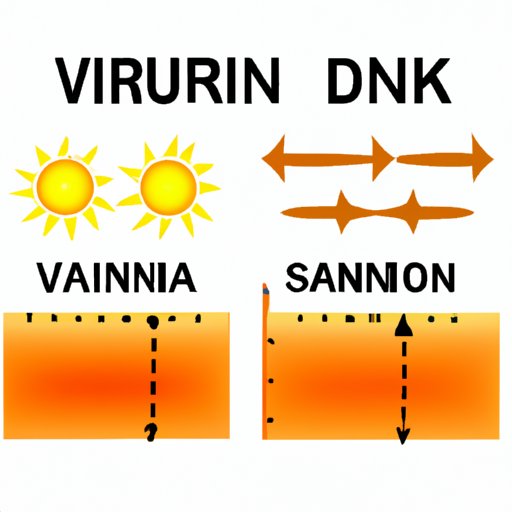Introduction
Have you ever wondered what causes the skin to turn brown after spending a few hours under the sun? Tan is a skin reaction caused by exposure to UV radiation from the sun or tanning devices. In this article, we will take a closer look at what tan is, how it works, the pros and cons of having a tan, tips and tricks for sunless tanning, the evolution of tanning, the connection between tanning and Vitamin D, debunking myths surrounding sun tanning, and tips for protecting your skin from harmful effects of tanning.
Discovering the Science Behind Tan and Understanding How it Works
Tanning is triggered by melanin production in the skin. Melanin is a pigment that darkens the skin in response to UV radiation from the sun or tanning devices. The level of melanin produced by the skin cells determines the shade of brown on the skin’s surface. The more melanin produced, the darker the tan will be.
UV radiation from the sun or tanning equipment triggers the melanocytes, specialized cells in the skin, to produce more melanin. Melanin acts as a natural sunscreen, helping to protect the skin cells from further damage.
The Pros and Cons of Having a Tan: Is it Safe for Our Skin?
Many people perceive a tan as a sign of beauty and health. However, tanning has both advantages and drawbacks.
One of the significant benefits of tanning is that it protects the skin from UV radiation. Melanin acts as a natural sunscreen and helps prevent further damage to skin cells. A tan can also hide blemishes such as acne scars, veins, and stretch marks, improving the appearance of the skin. Additionally, tanning promotes vitamin D production, which regulates calcium and phosphorus levels in the body, strengthens bones, and supports a healthy immune system.
However, tanning has harmful effects on the skin. Overexposure to UV radiation can cause damage to the skin cells, increasing the risk of skin cancer. The risk is much higher for individuals with fair skin and a history of sunburns. Tanning can also prematurely cause skin aging, leading to wrinkles, age spots, and leathery skin.
Achieving the Perfect Tan: Tips and Tricks for Sunless Tanning
Sunless tanning involves using products such as lotions, sprays, and gels to darken the skin without exposure to UV radiation. Here are some tips for achieving the perfect sunless tan:
There are two types of sunless tanning products: DHA-based products and cosmetic bronzers. DHA-based products react with amino acids on the skin surface, turning it brown. Cosmetic bronzers are temporary and can be washed off easily. The best time to apply sunless tanning products is after a shower when the skin is clean and dry. It is also essential to exfoliate the skin to get rid of dead skin cells that can cause an uneven application. When applying lotions or sprays, use a circular motion to ensure even distribution. It is also crucial to avoid areas with dry skin, such as elbows and knees, which can cause patchy areas.
The Evolution of Tanning: From Past to Present
Tanning has been around since ancient times. In ancient Greece, fair skin was a sign of wealthy aristocrats, and tanned skin signified lowly peasants who spent most of their time outdoors. However, it was not until the 1920s that tanning gained popularity when fashion designer Coco Chanel came back from a Mediterranean cruise with a bronzed complexion.
Throughout the 20th century, tanning equipment, such as sun lamps and tanning beds, became common. However, in recent years, there has been a shift towards sunless tanning, fueled by the dangers of skin cancer and the desire to protect the skin.
Tanning and Vitamin D: The Connection You Need to Know
Vitamin D is a vital nutrient that helps with calcium absorption and strengthening bones. The body can produce Vitamin D from exposure to UV radiation from the sun or tanning equipment. This is why spending a little time in the sun is essential for vitamin D production.
However, overexposure to UV radiation can harm the skin cells and cause more harm than good. It is essential to find the right balance between getting enough vitamin D and protecting the skin from damage.
Debunking the Myths Surrounding Sun Tanning and Protecting Your Skin
There are many common misconceptions about tanning and skin protection. One of the most common myths is that getting a base tan will prevent sunburns. However, a base tan only provides an SPF of 2-3 and does not provide adequate protection against UV radiation. It is essential to use sunscreen with an SPF of 30 or higher and reapply every two hours.
Another myth is that indoor tanning is safer than outdoor tanning. However, indoor tanning machines can emit up to 15 times more UV radiation than the sun, making them much more dangerous than outdoor tanning.
To protect the skin from harmful UV radiation, it is essential to use sunscreen, wear protective clothing, and avoid spending too much time in the sun during peak hours.
Conclusion
Tanning is a natural process that occurs when the skin is exposed to UV radiation. It helps the body produce Vitamin D and protects the skin from further damage. However, overexposure to UV radiation can cause skin damage and increase the risk of skin cancer. Sunless tanning is becoming more popular as people look for ways to protect their skin while still achieving a bronzed complexion. It is essential to stay safe in the sun by using sunscreen, protective clothing, and avoiding exposure during peak hours.
